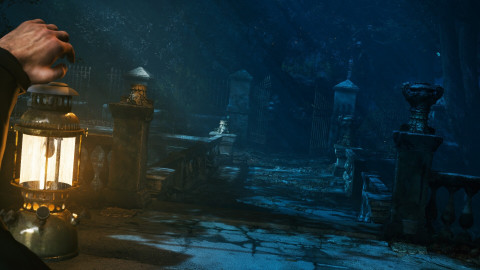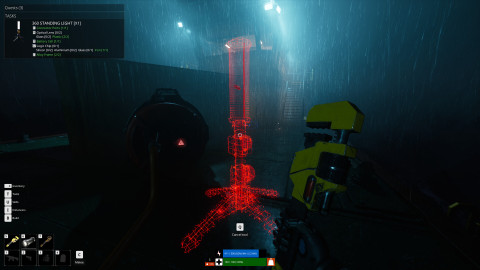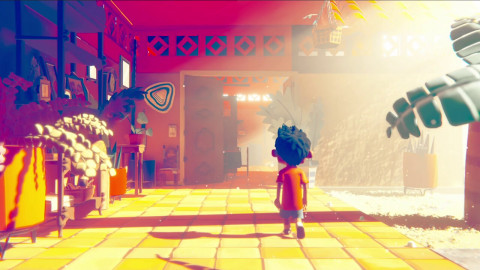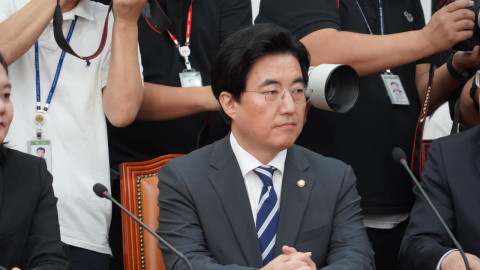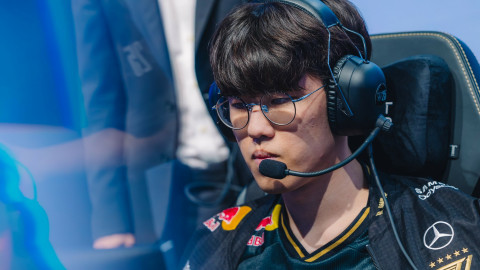
Last week, at G-Star 2022 held in Busan, Goose Goose Duck had a booth in collaboration with Inven, which had an extremely long line throughout the event. The many visitors and the selling merchandise showed the popularity of Goose Goose Duck in Korea.
On the second day, Gaggle Studios CEO Shawn Fischtein had a seminar at the Inven Game Conference — Social Gaming is the Next Social Network. After the seminar, Inven Global had a chance to speak with Shawn to talk about Goose Goose Duck.
First off, can you introduce yourself briefly?
My name is Shawn Fischtein. I'm the CEO and co-founder of Gaggle Studios based out of Toronto, Canada and the United States.
I don’t think Goose Goose Duck would need any introduction. How did you come up with the game in the first place?
We were a new company making social games, and we were playing Among Us to kind of tie over some of our social time with our team. Then we realized that there were missing parts of the game that we thought would make the game better.
We didn't want to have to mod the game, download mods, or build out a whole new section of the game to make it enjoyable for us. We decided we were going to build our own game. As we talked more about it, we contacted one of our investors. At the same time, they were trying to contact us with the same idea. We were in the best position with the best talent to create a social deduction game that would be one step up.
As you mentioned earlier, the game is somewhat similar to Among Us. Some people could consider the game a kind of mod or a spinoff from Among us. How did you make it different from it?
A lot of people would compare us to Among Us, but in our eyes, the way we look at Among Us is that it's more of a checkers game. It's a little bit more one-dimensional, a simpler game. What we decided to do was take it one step further and create a lot more chaos and a lot more variability.
We also wanted to solve some of the problems that we saw, which was not having voice integration and then designing around voice chat as a core mechanic of the game
as opposed to having to add it in later with 3rd party applications.
This allowed us a bunch of different design options, including things like being able to coordinate with your teammates while you are alive in different ways. That opened up the opportunities to introduce new mechanics like environmental kills as well as more strategic options for gameplay.
So although the games are more chaotic, they have a higher skill ceiling, and they can be experienced at different levels. Whether you have 100 hours in the game or 5,000 hours in the game, you can see a significant difference in ability.
The differentiator is that we opened up the whole genre and tried to create a lot more possibilities for the game, we elevated it to chess.

What was the core value when you were designing the game?
The core value was to adapt to what the players wanted and make sure the game was fun. We introduced a number of roles that really don't offer much strategy to the game, or so we thought they didn't add any strategy to the game, but they created a lot of fun and chaos.
In the end, we realized that the players were able to take fun and chaotic things that didn't have any core value to the strategies and they found strategies to work with them. They started playing the game in the ways that we didn't think they would. So for us, the main core value was fun, and if it wasn't fun, we didn't put it in.
Another core value was “frictionless”. We wanted to make it easy for people to create an account, find their friends, and join up with them. They didn't have to download any mods, and they didn't have to have any third-party chat applications. We wanted to make sure that it was accessible for everybody to play.
First, it's got to be fun and then it's got to be easy. Those were the two guiding principles for design, and they still are today as we enter the next generation of Goose Goose Duck.
How is it when the players find new things that you didn't expect them to do? Maybe some bugs?
Bugs are part of the experience. No game is without bugs. Every game, whether you're in an indie studio or your triple-A studio, you're going to have bugs. When you have a multiplayer game with 16 players, and you have server-side authority, you minimize some of it, but you also amplify any bugs that can happen just by the sheer number of players.
We actually watch a lot of streamers and a lot of gameplay. People post tons of content online. So whenever we catch something that doesn't look right or feel right we address it.
But, we rarely let bugs become features. It's just not a core principle of ours. We know there are games that do that. It's okay if the bugs are fun and people enjoy them, we let them stay. We haven't come across many of those in terms of gameplay where people have done something that was unpredictable.
When that happens, we quickly all meet up in our Discord chat, all the designers and developers, and we go, “Are we okay with this existing the way it does?” because we don't want things to turn into exploits, and we don't want to tilt the balance of the game.
Most of the time, very rarely have we ever had to intervene with the functionality of something. We're more just surprised — we tend to chuckle when we see players do something that we didn't expect could happen. That's kind of a fun moment for us too.
Goose Goose Duck merchandise is very popular. What kind of merchandise do the fans want the most?
Plushies! Everybody wants plushies. We did a very micro-sized campaign, and it went way better than we thought it would for plushies. One of the things that we also can do differently with our merch is that we can tie merchandise from the real world into the game.
So players tend to really like those pieces of merch where if they get it or they buy it in the real world, it comes with a code. They can also have that item in the game as well. We found that was very successful and people really enjoyed that.

We also noticed that younger kids tend to like our branding, our iconology. We're okay with that. If every kid in the world has a Goose Goose Duck lunch box or a Goose Goose Duck backpack, I think that'll be really cool. It's also fun for us to see little kids who actually don't play our game enjoy our branding while the adults in kind also enjoy our branding at the same level. We feel really honored and are really happy with the uptake on our merchandise.
It's become a core part of our design philosophy as well. For gaming, we designed something we wanted to be visually attractive so people will want to take that experience from the digital world into the real world with them. I think that's really important part of our studio and how we want to make an impact on gaming.
What more kinds of merch will be coming up?
We are going to be focusing more on plushies, that's a given. We do have some fashion stuff that we have in North America that does well. So we're assuming that it's going to start doing well outside of North America. We would love to be able to sign up with Funko Pop! or another licensing agency that has access to those, but I think we want to stick to everyday-use items like kitchen wear, mugs, cups, spoons — anything that you would use day to day and just kind of add some fun to your life wherever you go.
The fun would be there, but it will still kind of remain brutal as well. If you've played Goose Goose Duck, you know they're not friendly. They kind of go over the top when they kill each other. We still want to keep a little bit of that, which is why we think it's funny that little kids love our merch because it's cute on the surface, but everybody who sees it knows it's not.
Back to the game a little bit. How are the characters designed?
The character art is easy. We have a gentleman on our team by the name of Tex. His specialty is character art, and we just basically tell Tex to do whatever he wants. We give a lot of agency to our team members, especially the creatives, for designing the look and feel of the game, and I think they hit it out of the park.
As game designers or as producers inside our studio, we rarely like to step on the creative toes of our artists. That's how the characters are created. We let them run with their vision, and we actually designed the game around the look that they come up with. So they kind of happened at the same time, but we altered some of our designs to meet the look of the characters.

In terms of roles, it's a lot of arguing. There are a million and one things we can do in the game to make our characters and our roles. Typically, there's a period where we suggest something, and then the whole team meets, then we tear it apart. Most ideas never make it to the light of day because somebody will find something about that role that tips the balance, or it will skew the fun scale of the game heavily to one player.
Role ideas never die. They kind of just keep morphing until we're comfortable with a role that's going to make the game more fun. Once we decide to make it, usually between 48-72 hours later, it's in the game.
Does the role come first or is it the look?
The character designs, like the graphics, are always decided first, but then the mechanics of the role are designed, and then finally, the iconology for that role is created. That's usually how it goes. Roles will come organically, but the character design is already done.
One of the recent trends in gaming is the NFTs and Web3 tech. Are you planning to implement any?
We already kind of have this happening with how our codes are working in the game right now. Codes can be distributed in the real world, and they can be traded amongst players, but once they’re redeemed, they’re redeemed. Once they're converted from a real-world code into a digital asset, there's no tradability. It's locked for that account. The player then has the value of having that access to that, but if they no longer want it, they can no longer trade it.
We're going to utilize blockchain technology just to help us assist players in trading in-game assets from one player to the next. This also allows us to be extremely transparent and honest. If we say, we're only going to mint or make 100 of this cosmetic, players will know that they have number 72 out of 100, and they can see all hundred of them on everybody's wallet or account.
So for us, blockchain really just enables player-to-player transactions. We are absolutely going to have to do this in the future. It's been requested by our players, but we take a very different philosophical approach to blockchain gaming.
We don't believe it's been done right. We think if it doesn't empower the player and it doesn't improve the player's experience in the game, then it has no place in our game or in any game for that matter. If it isn’t fun, it becomes a cash grab for the studio, and that's not what we're about — we make free-to-play games. There are other ways to make money, and we believe if we're going to ask a player to open their wallet and give us something, it should be on their terms, not on ours. It's how we feel as a company
And any new updates for the game?
We have a new map coming out next month in December. “Ancient Sands”. It is Arabian-themed, so it's going to take place in the desert. It's going to feel like Egyptian-esque. Obviously, Egypt doesn't exist in our game universe, so it's heavily inspired by that relative period of time in human history. We are going to be introducing a number of new roles, one of whom we already brought out early.
We're also releasing an arcade for the lounge, where players can use their crafting materials that they've been collecting in order to interact with claw machines and win prizes which are cosmetics and other currencies. We are even toying with the idea that you could win tradable assets where you can trade and/or collect rare prizes — possibly, people could win a real-world prize just for playing our game. Maybe you can win a plushy or some merchandise.
We have an unending amount of ideas, but those are the two big ones that are coming up in the next little while. I also revealed that we are working on three and a half new games. Two of them are slated for release in 2023. They're all just as cute and just as fun. Hopefully, players will find them interesting enough to download and play them.

Sort by:
Comments :0



